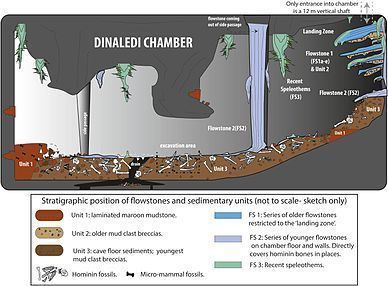 | ||
Location | ||
Inside the rising star cave
The Rising Star cave system (also known as Westminster or Empire cave) is located in the Malmani dolomites, in Bloubank River valley, about 800 meters (0.50 miles; 2,600 feet) southwest of Swartkrans, part of the Cradle of Humankind World Heritage Site in South Africa. Recreational caving has occurred there since the 1960s. Fossils found (starting in 2013) in the cave were, in 2015, proposed to represent a previously unknown extinct species of hominin named Homo naledi.
Contents
- Inside the rising star cave
- Caver rick hunter squeezing through the rising star cave
- Names
- History
- Discovery of fossils in Dinaledi Chamber
- 2013 and 2014 excavations
- Geology
- Description
- References
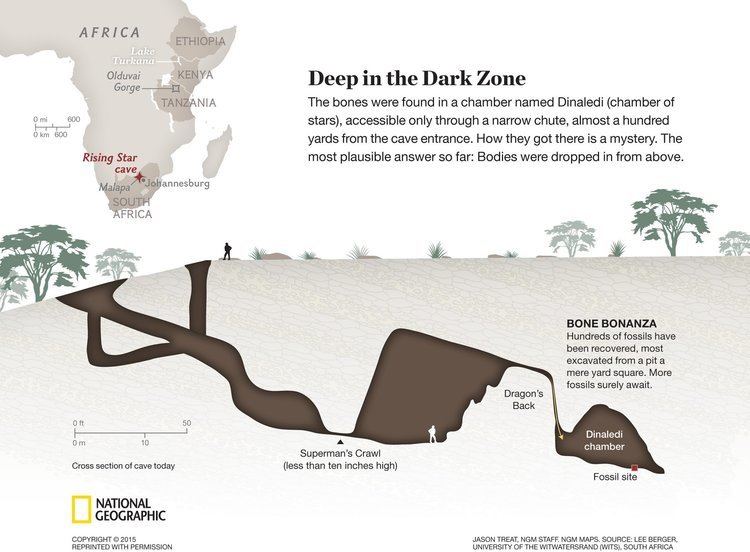
Caver rick hunter squeezing through the rising star cave
Names
In the 1980s, the names "Empire", "Westminster", and "Rising Star" were used interchangeably.
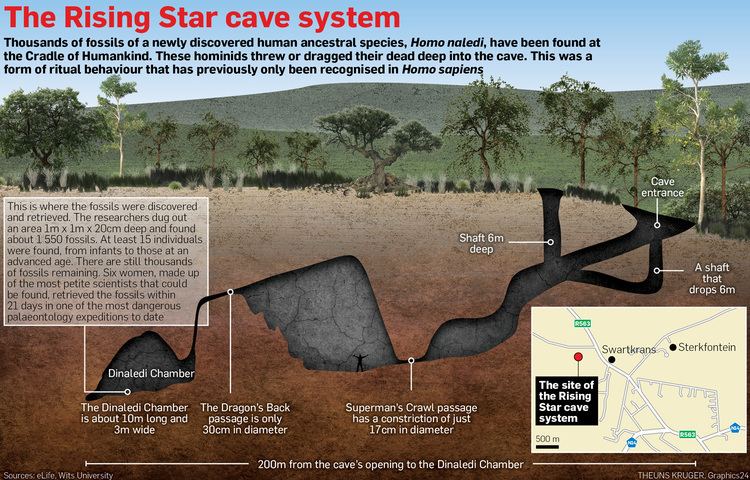
The species name, naledi (seSotho for "star"), and the "Dinaledi Chamber" (incorporating the Sotho word for "stars") were so named by members of the Rising Star Expedition in reference to the species and chamber's location in Rising Star Cave.
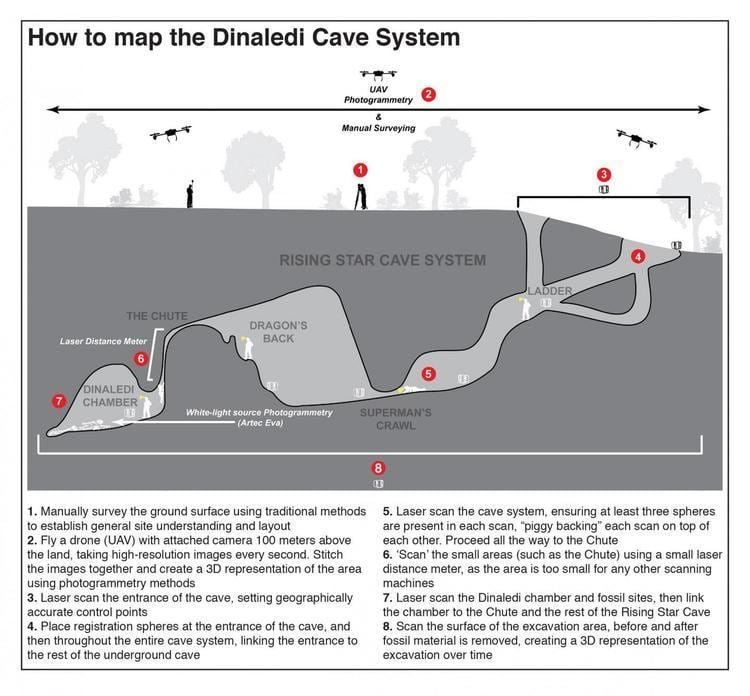
A portion of the cave, used by the excavation team en route to the Dinaledi Chamber, is called "Superman's Crawl" because most people can fit through only by holding one arm tightly against the body and extending the other above the head, in the manner of Superman in flight.
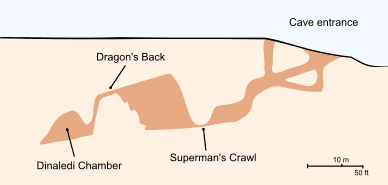
The Superman Crawl opens into the "Dragon's Back Chamber," which includes a approximately 15 m (49 foot) exposed climb up a ridge of a sharp-edged dolomite block that fell from the roof sometime in the distant past. This block is the so-called Dragon's Back, so named because the climbing route appears to progress from the tail to the head along the spiked spine of a mythical beast.
History
Geologists think the cave in which the fossils were discovered is no older than three million years.
The cave was explored in the 1980s by the Speleological Exploration Club (SEC), a local branch of the South African Speleological Association (SASA).
Discovery of fossils in "Dinaledi Chamber"
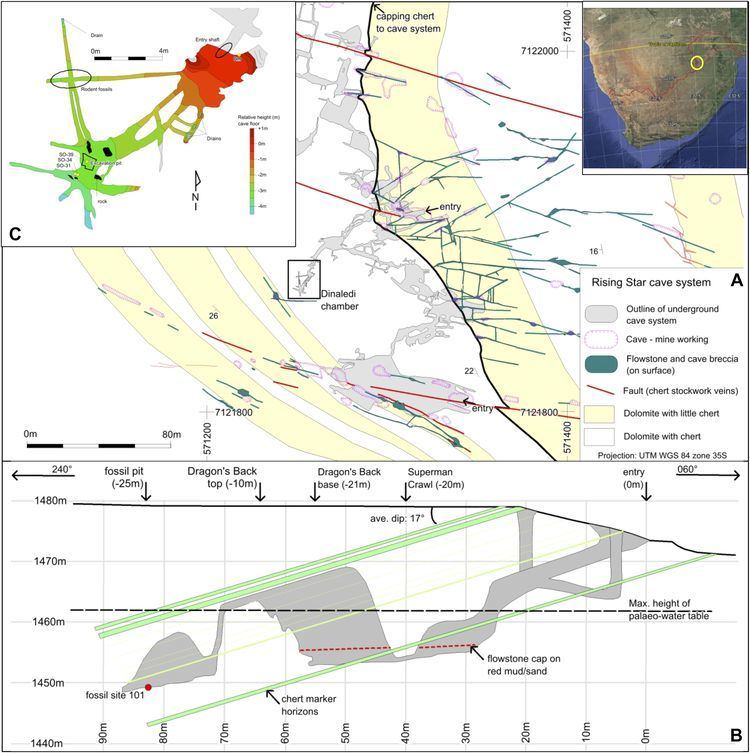
On 13 September 2013, while exploring the Rising Star cave system, recreational cavers Rick Hunter and Steven Tucker of the Speleological Exploration Club (SEC) found a narrow, vertically oriented "chimney" or "chute" measuring 12 m (39 ft) long with an average width of 20 cm (7.9 in). Then Hunter discovered a room 30 m (98 ft) underground (Site U.W. 101, the Dinaledi Chamber), the surface of which was littered with fossil bones. On 1 October, photos of the site were shown to Pedro Boshoff and then to Lee Berger.
The arrangement of bones, as well as several survey pegs, suggested "someone had already been there" as recently as a few decades earlier. The appearance of limited fossilisation initially led the explorers to think the bones were from the last caver into the chamber, who had subsequently never made it back out alive.
2013 and 2014 excavations
On 1 October 2013, paleoanthropologist Lee Berger was notified of the find, and he organized an expedition to excavate the fossils, which started on 7 November 2013. The expedition was funded by the South African National Research Foundation and the National Geographic Society.
The excavation team enlisted six paleoanthropologists, all of whom were female, who could pass through an opening only 18 cm (7 inches) wide to access the Dinaledi Chamber. Those chosen were Hannah Morris, Marina Elliott, Becca Peixotto, Alia Gurtov, Lindsay Eaves, and Elen Feuerriegel. They have since been nicknamed the Underground Astronauts.
The Dinaledi Chamber was assigned the designation UW-101 and was excavated by these six members of the Rising Star Expedition during November 2013. More than 1,200 fossil elements were recovered and catalogued in November 2013, representing at least a dozen individuals. Only 20 out of 206 bones in the human body were not found in the cave as of summer in 2014. By April 2014, between two localities, 1754 specimens were recovered.
The layered distribution of the bones [in clay-rich sediments] suggests that they had been deposited over a long time, perhaps centuries. Only one square meter of the cave chamber has been excavated; other remains might still be there.
On 20 February 2014, Rick Hunter, Lee Berger, John Hawks, Alia Gurtov, and Pedro Boshoff returned to Rising Star to evaluate a second potential site. The site, designated UW-102, was found by cavers Rick Hunter and Steve Tucker on the last day of the first Rising Star Expedition, and limited excavation began in April 2014.
As of September 2015, fossils of at least fifteen individuals, amounting to 1550 specimens, had been excavated from the cave. About 300 bone fragments were collected from the surface of the Dinaledi Chamber, and about 1250 fossil specimens were recovered from the chamber's main excavation pit, Unit 3. The fossils include skulls, jaws, ribs, teeth, bones of an almost complete foot, of a hand, and of an inner ear. The bones of both old and young individuals, as well as infants, were found.
The 15 partial skeletons, which were found in a small underground chamber, invite speculation on the circumstances of their location. Paleoanthropologist John D. Hawks, from the University of Wisconsin-Madison, who is a member of the team, has stated that the scientific facts are that all the bones recovered are hominin, except for those of one owl; there are no signs of predation, and there is no predator that accumulates only hominins this way; the bones did not accumulate there all at once. There is no evidence of rocks or sediment having dropped into the cave from any opening in the surface; no evidence of water flowing into the cave carrying the bones into the cave. Hawks concluded that the best hypothesis is that the bodies were deliberately placed in the cave after death, by other members of the species. Berger et al. suggest that "these individuals were capable of ritual behaviour." They speculate the placing of dead bodies in the cave was a ritualistic behaviour, a sign of symbolic thought. "Ritual" here means an intentional and repeated practice (disposing of dead bodies in the cave), and not implying any type of religious ritual. This hypothesis has been criticised for its improbability.
No chronometric dates of the fossil remains have been released, though the team has indicated that they plan to date calcite deposits in the cave. A study involving the statistical reconstruction of hominin evolutionary trees from skull and tooth measurements, indicates that the most likely age for H. naledi is 912 kya.
A collaborative workshop involving 54 local and international scientists took place in May 2014 at the University of the Witwatersrand, On 10 September 2015, the fossils were publicly unveiled and given the name Homo naledi.
Geology
The Rising Star cave system lies in the Bloubank River valley, 2.2 km west of Sterkfontein cave. It comprises an area of 250 × 150 m of mapped passageways situated in the core of a gently west dipping (17°) open fold, and it is stratigraphically bound to a 15–20 m-thick, stromatolitic dolomite horizon in the lower parts of the Monte Christo Formation. This dolomite horizon is largely chert-free, but contains five thin (<10 cm) chert marker horizons that have been used to evaluate the relative position of chambers within the system. The upper contact is marked by a 1–1.3 m-thick, capping chert unit that forms the roof of several large cave chambers. The altitude above sea level is 1450 m for the Dinaledi Chamber's floor.
Description
The fossil-bearing chamber, named the Dinaledi Chamber, is ∼30 m below the surface and ∼80 m, in a straight line, away from the present, nearest entrance to the cave. Access into the Dinaledi Chamber involves an exposed, ∼15 m climb from the bottom of a large ante-chamber (the Dragon's Back Chamber). From the top of the Dragon's Back, the Dinaledi Chamber is accessed via a narrow, northeast-oriented vertical fissure, and involves a ∼12 m vertical climb down ∼25–50 cm wide at its narrowest and ∼10 m long, and expands in width near the intersections with cross-cutting passages.
Access to the Dragon's Back Chamber is possible through two routes, both of which involve challenging ascents through narrow cracks and constricted pathways. The first route proceeds along an east-northeast direction, following a fracture for approximately 50 meters beyond a constricted entry known as the "Postbox." The second route navigates a more complex series of passages trending broadly east, traversing a sequence of southeast, east, and north fractures for about 120 meters, culminating in a tight entrance named "Superman's Crawl." The initial route offers a more straightforward path and leads to areas within the cave that have significant sediment deposits about 20 meters in. The second route, which was taken by the 2013 Rising Star Expedition, features a more intricate journey.
